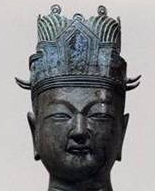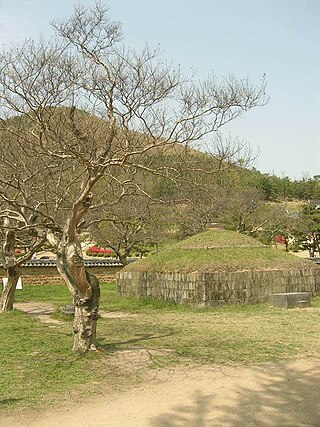Related Research Articles

Taejo of Goryeo, personal name Wang Kŏn, also known as Taejo Wang Kŏn, was the founder of the Korean Goryeo dynasty. Taejo ruled from 918 to 943, achieving unification of the Later Three Kingdoms in 936.

Sin Sung-gyŏm was a Korean general during the turbulent Later Three Kingdoms period in the early 10th century. Born in Gwanghaeju, he became a general in the kingdom of Taebong. He was instrumental in helping Wang Kŏn, who later founded the state of Goryeo to achieve power. He is widely viewed as the founder of the Pyongsan Shin clan, which includes the famous actress Shin Se-kyung.
Wonjong of Goryeo, personal name Wang Chŏng, was the 24th ruler of the Goryeo dynasty of Korea, reigning from 1260 to 1274. His rule was briefly interrupted by that of King Yeongjong in 1269, although the legitimacy of the latter is disputed by scholars.
Jeongjong of Goryeo, personal name Wang Yo, was the third king of the Goryeo dynasty of Korea. He was the third son of King Taejo, the dynastic founder.
Mokjong of Goryeo, personal name Wang Song, was the seventh ruler of the Goryeo dynasty of Korea.
The Goguryeo controversies are disputes between China and Korea on the history of Goguryeo, an ancient kingdom located in present-day Northeast China and the Korean Peninsula. At the heart of the Goguryeo controversy is which part of history the kingdom belongs to. Korean scholars have the viewpoint that Goguryeo is part of Korean history alone.

The Pyongsan Shin clan is one of the great aristocratic houses which originated from Korea. The clan was key in the foundation of the Goryeo dynasty and gained its power during this time. However, it became less prominent during the following Joseon dynasty.
Duke of Angyeong, personal name Wang Ch'ang, also known by his temple name as King Yeongjong of Goryeo, was briefly king of the Korean Goryeo dynasty in 1269 installed by the Goryeo military regime. He was the second son of King Gojong and the only full younger brother of King Wonjong. He was known before his reign as the Marquess of Angyeong and Duke of Angyeong. Although he was given the temple name of Yeongjong by the Goryeo court, his reign's legitimacy is not widely recognized by modern-day scholars.
Kang Ho-gyeong was the first and oldest ancestor of Taejo who established Goryeo dynasty. His name can be found in Korean historical literature such as Goryeosa and Pyeonnyeon-Tong-Rok. He is the founder of the Sinchon Kang Clan. While he is known to be the clan's founder, some regard the clan's semi-founder to be Kang Ji-yeon, the descendant of Kang Ho-gyeong, to be more of the clan's official progenitor.

Queen Janghwa of the Naju Oh clan was the second Goryeo queen consort through her marriage as the second wife of Wang Geon, its founder and became the mother of his heir and oldest son, King Hyejong.
Gang Yun-seong was a civilian of the Korean kingdom of Goryeo. He was a father of Queen Sindeok who was the second wife of King Taejo of Joseon or known as Yi Seong-gye.
Gukjo of Goryeo was believed to be the great-grandfather of Wang Geon, founder of the Goryeo dynasty. In around 918, he was Posthumously honoured as King Wondeok the Great.
Queen Jeonghwa of the Sincheon Gang clan, personal name Gang Jin-ui, was the second daughter of Gang Bo-yuk who would become the great-grandmother of Wang Geon, founder of the Goryeo dynasty. As a figure from the Later Silla period, she is the first one from among the ancestors of King Taejo to be accurately reported by the left records.
Chakchegŏn was a Korean hojok, or local regional lord, of Songak during the late Silla. He was a powerful and rich figure in the region, with influence over local Yellow Sea maritime trade. He would become the grandfather of Wang Kon, the founder of Goryeo. After Goryeo's establishment, he was given a posthumous name of King Gyeonggang the Great along with his temple name of Uijo in 918. He was buried in Onhyereung tomb.
Sinchon Kang clan is a Korean clan from Sinchon County, Hwanghae Province. According to a census held in 2015, the clan has 52,945 members and in a census held in 2000, the clan had 13,909 families.
Pyongsan So clan was one of the Korean clans. Their Bon-gwan was in Pyongsan County, Hwanghae Province. According to the research in 2000, the number of Pyongsan So clan was 725. Pyongsan So clan was one of the descendants of Duke of Shao’s family in Zhou dynasty. Their founder was So Gwang bin who was a government official in Gyeongsang Province, Goryeo, during Myeongjong of Goryeo’s reign.
Lady Sinjuwon of the Sincheon Gang clan was the daughter of Gang Gi-ju who became the 23rd wife of Taejo of Goryeo.
Great King Munwon was a Korean Royal Prince as the 5th son of Taejo of Goryeo and Queen Sinmyeong, also the younger brother of Tae, Yo and So. He later married his half sister, had 2 sons and a daughter who would eventually become the 2nd wife of King Gyeongjong, his nephew. Although his death date was unclear, it considered that he died during the latter half of Gwangjong's reign.
Queen Sinseong or formally called as Queen Dowager Sinseong was a Silla royal family member as the first cousin of King Gyeongsun who became the fifth wife of Taejo of Goryeo and the mother of Anjong of Goryeo, also the grandmother of Hyeonjong of Goryeo which she later posthumously honoured as queen in 1010 under his command.
Queen Sinmyeong of the Chungju Yu clan or long-called as Queen Sinmyeongsunseong was the third Goryeo queen consort through her marriage as the third wife of Wang Geon, its founder and become the mother of his 5 sons and 2 daughters.
References
- ↑ "건국설화와 고려". 문화콘텐츠닷컴 (in Korean). Korea Creative Content Agency. Retrieved 17 April 2018.
- 1 2 "5) 사상의 지형이 다른 두 역사책; 『삼국사기』와 『편년통록』". 우리역사넷 (in Korean). National Institute of Korean History . Retrieved 17 April 2018.
- ↑ 이덕일. "[이덕일 사랑] 대~한민국". 조선닷컴 (in Korean). The Chosun Ilbo . Retrieved 2 July 2018.
- 1 2 3 "경강대왕(景康大王)". Encyclopedia of Korean Culture (in Korean). Academy of Korean Studies . Retrieved 15 April 2018.
- ↑ "진의(辰義)". Encyclopedia of Korean Culture (in Korean). Academy of Korean Studies . Retrieved 17 April 2018.
- 1 2 "의조경강대왕(懿祖景康大王)". Encyclopedia of Korean Culture (in Korean). Academy of Korean Studies . Retrieved 16 April 2018.
- ↑ 이은식 (2014). 필수역사용어해설사전 (in Korean). 타오름. p. 227. ISBN 9788994125855.
- ↑ "평산군(平山郡)". Encyclopedia of Korean Culture (in Korean). Academy of Korean Studies . Retrieved 16 April 2018.
- ↑ "황해도 평산(평산장)". 문화콘텐츠닷컴 (in Korean). Korea Creative Content Agency. Retrieved 16 April 2018.
- ↑ "서명 : 평산군지(平山郡誌)". 서울대학교 규장각 지리지 종합정보. Seoul National University. Retrieved 16 April 2018.
- ↑ "세종실록 152권, 지리지 황해도 연안 도호부 평산 도호부". 조선왕조실록 (in Korean). National Institute of Korean History . Retrieved 16 April 2018.
- ↑ Rogers, Michael C. "P'yŏnnyŏn T'ongnok: The Foundation Legend of the Koryŏ State." Journal of Korean Studies, vol. 4, 1982, p. 3-72. Project MUSE, https://doi.org/10.1353/jks.1982.0005. QUOTE: "Very different was the reaction of the scholars of the early Yi who compiled the Koryŏ-sa. They contemptuously dismiss the story, commenting that whether applied to Su-tsung or to Hsüan-tsung it was no more than a specious product of Sŏn records, hence unworthy of credence. (p. 43-44)
- ↑ "원덕대왕[元德大王,?~?]". Doosan Encyclopedia (in Korean). Doosan Corporation. Retrieved 16 April 2018.
손호술은 그가 귀인임을 알아보고 작은딸 진의와 맺게 하였는데, 진의는 숙종과 동침한 후 왕건의 할아버지 작제건(作帝建)을 낳았다고 한다. 그러나 이 이야기는 고려 왕실의 정통성을 강조하기 위해 왕건의 가계를 당나라의 황실과 연계하여 지어낸 것으로 보인다.
- ↑ 배한철 (13 September 2016). "용을 닮았다는 고려 왕건은 귀공자 형상". 얼굴, 사람과 역사를 기록하다 (in Korean). Maekyung Publishing. ISBN 979-11-5542-547-3.
- ↑ 배한철 (20 March 2020). "용을 닮았다는 고려 왕건은 귀공자 형상". 얼굴, 사람과 역사를 기록하다(리커버 에디션) (in Korean). Maekyung Publishing. ISBN 979-11-6484-092-2.
- ↑ 허인욱. "고려도경 [高麗圖經] "외국인의 눈에 비친 12세기 고려의 모습"". 한국사 콘텐츠 (in Korean). National Institute of Korean History . Retrieved 17 April 2018.
- ↑ 박종기 (2015). 고려사의 재발견: 한반도 역사상 가장 개방적이고 역동적인 500년 고려 역사를 만나다 (in Korean). 휴머니스트. ISBN 9788958629023 . Retrieved 17 April 2018.
- ↑ 김성회 (2 April 2013). "[김성회의 뿌리를 찾아서] <46> 진주강씨·신천강씨 등". Segye Ilbo . Retrieved 15 April 2018.
- ↑ "강씨(康氏)의 본관". 뿌리를 찾아서. RootsClick. Archived from the original on 25 November 2016. Retrieved 15 April 2018.